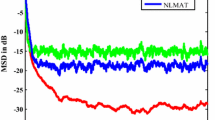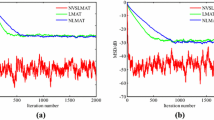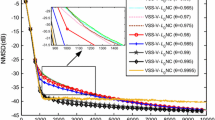Abstract
The study of signal processing has recently devoted significantly more attention to adaptive filtering techniques. By addressing the shortcoming of the conventional geometric algebra-based fixed step-size least mean square algorithm that is unable to satisfy in terms of both reducing steady-state error and a faster convergence speed, simultaneously, this study presents an improved logarithmic function-based variable step-size least mean square geometric algebra adaptive filtering algorithm by establishing the step-size factor \(\mu \) and error signal e(n) nonlinear function relationship. The instantaneous values of a current error estimate e(n) and the previous error estimate \(e(n-1)\) are used to determine the step size of the defined algorithm. Besides, an extensive discussion is given on the performance of algorithm under influence of parameters \(\varvec{\gamma }\) and \(\varvec{T}\) as well as comparative analysis with other existing geometric algebra-based adaptive filters. Computer simulation reveals that the proposed approach not only has a low steady-state error, robustness against impulsive noise, and fast convergence speed, but it also overcomes some existing algorithm’s instability under steady-state phase.








Similar content being viewed by others
Data availability statement
The data analyzed in this study are available upon reasonable request.
References
Boroujeny, F.: Adaptive filters Theory and applications, 2nd edn. Wiley, Hoboken (2013)
Jingfan, Q., Jingzheng, O.: A novel variable step size LMS adaptive filtering algorithm. J. Data Acquis. Process. 12(3), 171–194 (1997)
Yin, G., Shengli, X.: A Variable step size LMS adaptive filtering and its analysis acta electronica sinica 29(8), 1094–1097 (2001)
Xiaodong, L., Zhenhong, J., Qiang, W.: A new variable step size LMS adaptive filtering algorithm. Acta Electronica Sinica 34(6), 1123–1126 (2006)
Jianbo, D., Xinguo, H., Zhengguo, W.: Variable step size adaptive filtering LMS algorithm based on tongue-like curve. J. Data Acquis. Process. 19(3), 282–285 (2004)
Zhang,J., Wang, C., Yang,H.: LMS equalization algorithm based on inverse tangent in visible light communication. Opt. Commun. Technol., (2018)
Zhang, L., Wang, B., Liu, S.: A novel variable step-size adaptive interference cancellation algorithm. Acta Electronica Sinica, (2017)
Yang, Y., Jing, X., Zhang, Z.: Adaptive interference cancellation for coherent and uncorrelated interference signals coexistence. IEEE Conference, (2013)
Ao, W., Xiang, W., Zhang, Y.: A new variable step size LMS adaptive filtering algorithm. IEEE conference Computer Society, (2012)
Li, Y., Wang, X.: A modified VS LMS algorithm. The International Conference on Advanced Communication Technology. IEEE, (2007)
Wang, R.: GA-SURF: A new speeded-up robust feature extraction algorithm for multispectral images based on geometric algebra. Pattern Recognit. Lett. (2019)
Wang, R.: L1-norm minimization for multi-dimensional signals based on geometric algebra. Adv. Appl. Clifford Algebras, (2019)
Wang, R.: Multivector sparse representation for multispectral images using geometric algebra. IEEE Access 7, (2019)
Shen, M.: Joint sparse representation model for multi-channel image based on reduced geometric algebra. IEEE Access 6, (2018)
Wang, R.: Geometric algebra in signal and image processing: a survey. IEEE Access 7, (2019)
Lopes, W.B.: Geometric-algebra LMS adaptive filter and its application to rotation estimation. IEEE Signal Process. Lett. (2016)
Nuaimi, A.: 6DOF point cloud alignment using geometric algebra-based adaptive filtering. In: IEEE Winter Conference on Computer Vision, (2016)
Wang, H.: An approach to adaptive filtering with variable step size based on geometric algebra. IET Communications (2021)
Baylis: Clifford geometric algebras: with applications to physics, mathematics, and engineering. Springer Science and Business Media, Berlin (2012)
Xie, W.X.: Analysis of hybrid sensor network coverage based on the theory of Clifford algebras. Sci. Inf. Sci, China E Series (2007)
Bayro, C., J, E., Arana, D.: Clifford support vector machines for classification, regression, and recurrence. IEEE Trans. Neural Netw. (2010)
H, D.: New foundations for classical mechanics. Dordrecht, The Netherlands Springer, (1999)
Crowe, M.J.: A history of vector analysis: The evolution of the idea of a vectorial system,Amer. J. Phys. (1987)
V, J., Jayme, D., Rocha, R.: An introduction to clifford algebras and spinors. Oxford, U.K.: Oxford Univ. Press, (2016)
H. G, Society, L. M.: Ausdehnungslehre History of Mathematics. Providence, RI, USA: American Mathematical Society, (2000)
Hitchin: Clifford algebra to geometric calculus: A unified language for mathematics and physics. Bull. London Math. Soc (1985)
Strogatz: Nonlinear dynamics and chaos: With applications to physics, biology, chemistry, and engineering. Comput. Phys. (2015)
Lopes, W., Lopes, CG.: Geometric-algebra adaptive filters. IEEE Trans. Signal (2019)
Funding
This work was supported by the National Natural Science Foundation of China (NSFC) under Grant 61771299.
Author information
Authors and Affiliations
Contributions
KS involved in conceptualization, methodology, simulation, and writing original draft of manuscript. WR took part in supervision, validation, project administration, review & editing the manuscript, and funding acquisition. JJ involved in formal analysis, review, and editing.
Corresponding authors
Ethics declarations
Conflict of interest
The authors declare no conflict of interest.
Additional information
Publisher's Note
Springer Nature remains neutral with regard to jurisdictional claims in published maps and institutional affiliations.
Rights and permissions
Springer Nature or its licensor (e.g. a society or other partner) holds exclusive rights to this article under a publishing agreement with the author(s) or other rightsholder(s); author self-archiving of the accepted manuscript version of this article is solely governed by the terms of such publishing agreement and applicable law.
About this article
Cite this article
Shahzad, K., Wang, R. & Jamshid, J. A novel approach to geometric algebra-based variable step-size LMS adaptive filtering algorithm. SIViP (2024). https://doi.org/10.1007/s11760-024-03196-z
Received:
Revised:
Accepted:
Published:
DOI: https://doi.org/10.1007/s11760-024-03196-z




